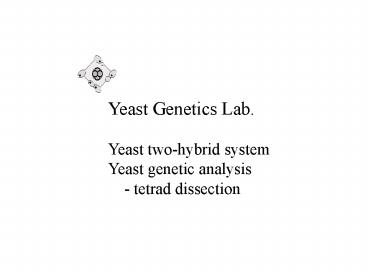Yeast Genetics Lab. - PowerPoint PPT Presentation
1 / 29
Title: Yeast Genetics Lab.
1
Yeast Genetics Lab. Yeast two-hybrid
system Yeast genetic analysis - tetrad
dissection
2
Functional genomics
Structural genomics
Proteomics
DNA sequencing analysis
mRNA transcript analysis
Proteome analysis
Network analysis
- DNA chips
- cDNA arrays
- Differential display
- DNA sequencing
- S.N.P.
- Gene mapping
- Positional cloning
- 2-D gel electrophoresis
- Mass spcetroscopy
- Protein chips
- Yeast two-hybrid
- Phage display
- Affinity assay tech
- Protein chips
- Systematic gene knockouts
- Transient gene inactivator
3
Protein-Protein interactions
- Biochemical approaches
- 1. Protein affinity chromatography
- 2. Affinity blotting
- 3. Immunoprecipitation
- 4. Cross-linking
- Genetic approaches
- 1. Extragenic suppressor
- 2. Synthetic lethal effects
- 3. Overproduction phenotypes
- Library-based approaches
- 1. Protein probing - ?gt11 library
- 2. Phage display
- 3. Two-hybrid system
4
(No Transcript)
5
How the two-hybrid system works If the two
proteins interact, the reporter gene (here HIS3)
is switched on and the diploids can grow on -His
plates
If the two proteins don't interact, the reporter
gene remains inactive and the cells can't grow on
-His plates
6
(No Transcript)
7
(No Transcript)
8
New versions
- Different characteristics
- NLS
- Transactivation capability VP16gtGal4AD gt B42
- counterselection CYH2
- Inducible expression galactose, methionine
-
pB42AD pGilda (LexA) - e. With T7 promoter for expressing proteins in
E.coli
9
(No Transcript)
10
(No Transcript)
11
Problems and limitations
- Post-translational modification glycosylation,
disulfide bond formation, phosphorylation - solution-ectopic expressed protein (such
as kinase) - Bait fusion protein can activate expression of
reporter in the absence o activation-domain
fusion partner - solution - 3AT or to use different
domains as baits - Some fusion proteins are harmful to yeast
- solution use inducible system (Gal
induced protein expression - 4. False-positive clones
- solution use unrelted protein as a bait
to reconfirm the specificity
12
Advantages ad disadvantages of yeast 2-H
- Advantage
- direct identification of DNA sequence of
interacting protein - No antibodies requries
- Protein purification not necessary
- In vivo-protein in native conformation?
- Detect low affinity or transient interactions
- Disadvantage
- -failed to detect some know interactions
- gene encoding target protein must be available
- Bait and prey must be soluble for nuclear
localization - Independent verification of interaction is
recommended - False positives
- Possible incorrect protein folding in yeast
- Stable expression of fusion protein might be a
prlblem - Not approapriate post-translational modifications
13
False positives in general
Found as false positives in other systems
Real interactions (found in IT)
Found as false positives in IT
Proteins
16
5
-
hsps
Ribosomal proteins
1
14
3
Cytochrome oxidase
5
-
1
Mitochondrial proteins
3
1
2
Proteasome subunits
4
3
-
-
ferritin
2
4
tRNA synthase
1
3
-
Collagen related proteins
3
-
-
3
2
Zn finger proteins
4
vimentin
2
-
-
Inorganis pyrophosphate
-
-
2
PCNA
2
-
-
Others 5 mitochondrial proteins (hsp, ribos,
cyt.C oxidase, ATP-synth.)
The most common trash reported elongation
factor, ferritin
14
Hope for the best..
- Major traps for a hunter
- Transactivation of bait protein itself
- Failure to express the bail properly
- Solution abandon hunts without even starting
a screen
15
Total failure 16/115 library screening (no
positives or only false positives
- 4/16 difficulties with protein expression
- 3/16 weak transactivation by the bait protein
- 2/16 primary transformants non-representative
for the complexity of the genome - 1/16 transformants were plated directly on
selective medium - 2/16 no obvious reasons
- 4/16 did not provide any clues
16
Your chance of success
- If your protein is properly expressed and is not
activating the reporters odds are 6 to 1 that you
will pull out womething which makes biological
sense, if you screen an adequate number of clones
(1-2 x 106 primary transformants for human cDNA
library - If your protein is weakly transactiating, your
chances drop, but not really dramatically. - If you cannot detect your bait protein in yeast,
your chance drop substantially.
17
The degree of your success can vary! The
complexity of many genomes and the complexity of
the web of protein interactions is beyond of the
abilities of any human-made systems. So, you will
find not necessarily what you want to find, it is
better not to be ruled by preconceptions and to
be aware of the limitation of the system. Two
hybrid systems - gt to uncover unanticipated
interactions.
18
PJ69-2A (bait)
Ade
19
????? Services Provided
- ??????????
- ?? pre-transformed libraries
- ???????????????
?????? Technology Development
- ????????????
??????????? Other yeast techniques
- ????????????(??)
L6
20
Pre-transformed Libraries
L6
21
(No Transcript)
22
Reverse two-hybrid system
23
Three hybrid system
24
Other alternative two-hybrid system
Cell membrane
Sos
Cell membrane
Y
Sos
Ras activation
Ubiquitin
25
The Yeast Protein Linkage Map is an attempt to
identify as many protein-protein interactions
among yeast proteins as possible by testing all
possible protein pairs (I.e. 6000 x6000 36 x
106 ) for interactions by individual two-hybrid
tests. http//depts.washington.edu/sfields/yp_proj
ect/index.html
26
How to make 6000 GAL4-AD clones
First round PCR Using specific primers With
common tails
Recombination cloning
Re-PCR using common primers
27
Analysis of protein-protein interaction
(PathCalling) e.g.AKR1 http//portal.curagen.co
m/extpc/com.curagen.portal.servlet.PortalYeastList
28
Yeast Resources for Funcional Genomic Studies
Deletion strains I (from Research Genetics or
from ATCC) http//www.resgen.com/products/YEASTD.p
hp3 - ordering Search form http//www-deletion.s
tanford.edu/cgi-bin/deletion/search3.pl
29
References for yeast genetics. Molecular Biology
of the Gene 2nd ed. Chapter 18 An Introduction
to the Genetics and Molecular Biology of the
Yeast Saccharomyces cerevisiae Fred
Sherman Department of Biochemistry and
BiophysicsUniversity of Rochester Medical
School, Rochester, NY 14642 1998 http//dbb.urmc.
rochester.edu/labs/Sherman_f/yeast/Index.html
Web sites SGD Saccharomyces Genome
database http//genome-www.stanford.edu/Saccharomy
ces/ MIPS Comprehensive Yeast Genome
Database http//mips.gsf.de/proj/yeast/CYGD/db/ind
ex.html YPD Yeast Protein Database http//www.pro
teome.com/databases/index.html































